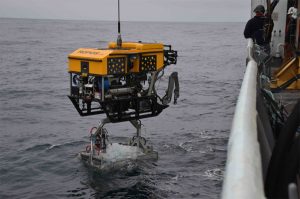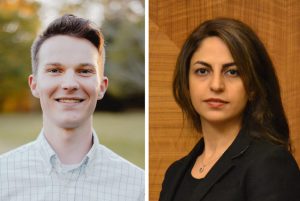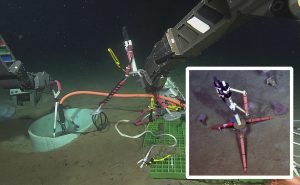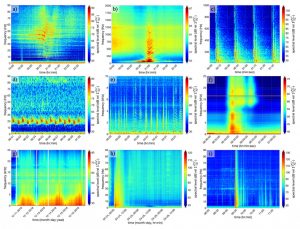By Wayne Gillam | UW ECE News

A remotely operated vehicle being submerged in the ocean to deploy hydrophones tethered to the NSF Ocean Observatories Initiative’s Regional Cabled Array, which is a network of ocean floor fiber optic cables located off the coast of Oregon. UW ECE doctoral student John Ragland and his adviser, UW ECE Adjunct Professor Shima Abadi, use hydrophones connected to the Regional Cabled Array to listen to random, ambient noise in the ocean and collect data related to climate change. | Photo courtesy of John Ragland.
The ocean can be a dark place. This vast body of water covers most of the surface of the earth and, on average, is over two miles deep. Light from above can’t penetrate more than 200 meters below the surface, which means that most of the ocean is shrouded in darkness, making gathering information about its depths a difficult challenge.
The ocean can also be a noisy place. Wind across its surface, rain falling from above, passing ships, whales and earthquakes on the ocean floor all generate underwater sound waves that crisscross and travel for long distances. But the underwater cacophony has an unexpected use. Over the years, scientists and engineers have figured out methods for extracting valuable information from this random, ambient noise, and it has enabled them to do things such as map the deep ocean floor, gather data on currents and estimate water temperatures.
However, there is a need for these techniques to be refined. For example, gathering data with greater accuracy from ambient noise would allow finer-scale estimates of the heat content of the ocean and aid in the modeling of how heat transfers through ocean currents. It could even help scientists better understand how that heat transfer process is being affected by human-caused climate change.

UW ECE third-year doctoral student John Ragland (left) and his adviser, UW ECE Adjunct Professor Shima Abadi (right)
UW ECE doctoral student John Ragland is investigating signal-processing and data-driven techniques for listening to ambient noise in the ocean. His research is aimed at improving these techniques, providing scientists with more powerful tools for accurately measuring ocean temperature and underwater environmental processes impacted by climate change. In December 2022, he presented his work to an audience of experts in ocean acoustics at the Acoustical Society of America’s national conference, where he received a Best Paper Award for his presentation — a high honor and an acknowledgement of his accomplishments.
“John has been working on this for a couple of years, and the amazing thing that he did in his presentation was to provide an overview of the field from theory to simulation and experiment,” said Ragland’s adviser, Shima Abadi, who is the director of the Ocean Data Lab, an associate professor of oceanography and an adjunct associate professor at UW ECE. “It was one of the most unique presentations I’ve seen in this field, and it combined everything from different perspectives.”
“I’m thrilled to be recognized by the experts in the field of underwater acoustics, for them to recognize that the research I’m doing is important,” Ragland said. “It feels validating, and I’m excited to continue the work.”
Ambient noise interferometry

A hydrophone being deployed on the ocean floor, from the point of view of the remotely operated vehicle being used to install it. (Inset) A fully installed hydrophone, mounted to the ocean floor. | Photo courtesy of John Ragland
Ragland is exploring a method for gathering information underwater called “ambient noise interferometry.” Interferometry is a technique that uses the interference of superimposed waves (usually light, radio or sound waves) to extract information. On land, seismologists use data from seismic sensors and interferometry to help them map the crust of the earth, especially in hard-to-reach places such as volcanic magma chambers. In the ocean, scientists record random, ambient noises (such as wind, rain, and the motors of passing ships) with hydrophones and use interferometry to map the deep ocean floor. It’s akin to walking into an unknown area blindfolded and learning details about the size and shape of the space only through what can be heard, rather than by what can be seen.
“Imagine that you are in an empty room, and you clap your hands,” said Abadi, by way of example. “You’ll hear all the reflections of the sounds at different arrival times. And that’s exactly what happens in the ocean when sound is made. The sound bounces off from its boundaries, which are the ocean surface and floor — and we capture those echoes at any location where we have a receiver, such as a hydrophone.”
Ragland’s research focuses on using ambient noise interferometry to characterize — with a high degree of mathematical accuracy — how acoustic waves propagate in the ocean. Reaching this level of precision in wave characterization will in turn allow scientists and engineers to estimate ocean temperatures more accurately.
“In the ASA presentation, what I did that was unique was to demonstrate through simulation how different depths, ranges or sound sources (such as a single ship, or a vocalizing whale or perhaps a seismic earthquake) would affect the estimate of acoustic wave propagation,” Ragland said. “By doing this, we gained a deeper understanding of how specific sound source locations affect this technique of ambient noise interferometry.”
Another aspect of Ragland’s work is developing open-source tools to help scientists and engineers use hydrophone data freely available from the National Science Foundation’s Ocean Observatories Initiative. Ragland has co-produced an open-source Python package, known as OOIPY, which allows easy download of this data and analysis. He is also working with Abadi and her students to develop a website that provides a way to explore data being analyzed.
“The hydrophone data is open access, but because it is such a large data set, there were not that many tools available for easy access and processing,” Abadi said. “John was one of the first people who developed an open-source tool for easy access. Many researchers are now using his tool for taking advantage of this rich dataset.”
An expanded data set

Spectrograms of notable acoustic features in the NSF Ocean Observatories Initiative’s dataset, which Ragland and Abadi use in their research. These recordings of random, ambient noise in the ocean were collected by hydrophones located on the Regional Cabled Array. From top, left to right — (a) A cargo ship passing by a low-frequency hydrophone (b) The same ship event recorded with a broadband hydrophone (c) Sounds of an air-gun being fired (d) Fin whale vocalizations (e) Marine mammal vocalizations (f) Rain falling on the ocean’s surface (g) Wind blowing over the ocean (h) The eruption of the Axial Seamount volcano on April 24–26, 2015 (i) A 6.2 magnitude earthquake that occurred 319 kilometers from the recording hydrophone on August 22, 2018. | Image provided by John Ragland
Ragland is currently using two hydrophones located in the northeast Pacific Ocean for his own research, so one of the next steps for his work will be to expand the data set he is working with to cover a wider expanse of ocean. In the near future, he and Abadi will be using an approach that is considered non-traditional in ocean acoustics — leveraging fiber optic communication cables that run back and forth across the ocean floor. Ragland and Abadi plan to continuously collect data all along the length of these 100- to 200-kilometer cables, in addition to pulling data from hydrophones. This will vastly expand the reach of their data collection and analysis across a much larger spatial and temporal scale.
Ragland said that he also anticipates developing new techniques for ambient noise interferometry that will allow for a more accurate estimate of ocean temperature, and this will help researchers better understand how climate change is affecting the world’s oceans.
“If the ocean is getting warmer, it has a big impact on the speed of sound that we can capture in this analysis,” Abadi said. “John is using seven years of data collected since 2015, and the data is accumulating. So, in the next couple of years, we will be able to do almost 10 years of data analysis and find out the overall trend of ocean ambient noise.”
“I’ve always been intrigued by being able to use signal processing techniques or math to be able to get previously hidden information out of some sort of measured signal,” Ragland said. “I’ve always found that interesting, and this is a unique application of that. But the fact that ambient noise interferometry has direct applications to climate change and measuring the ocean system is important, and I’m excited about the direction my research is taking me in this area.”
John Ragland’s research is supported by the Office of Naval Research, and the data he works with is gathered by the National Science Foundation’s Ocean Observatories Initiative. For more information, view Ragland’s ASA presentation or contact John Ragland or Shima Abadi.

